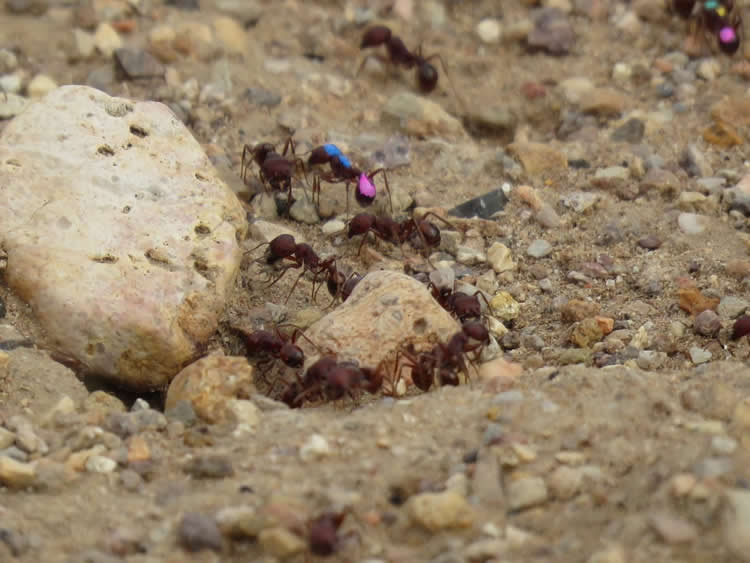Summary: A new study reports dopamine may have an impact on foraging behavior in ants. Researchers report ants treated with dopamine went on more foraging trips and appeared to be more sensitive to humidity.
Source: Cell Press.
In an ant colony, few tasks are as important as gathering food. But the desert heat can pose a challenge for an ant on foraging duty. Recent findings, publishing in the journal iScience on September 27, show how dopamine may influence the behavior of ant foragers in the desert.
“If there’s one thing you can say about an individual ant’s behavior, it’s that it’s doing it for the colony,” says Daniel Friedman, first author and biology PhD candidate at Stanford University. “An ant colony acts almost like a multicellular organism; the colony is the evolutionary unit. We wanted to see if collective behavioral variations among colonies were associated with differences in individual forager brain chemistry.”
First, Friedman’s team collected foragers from six previously studied colonies of red harvester ants in the Arizona desert. Half of the colonies foraged often in dry weather, while the others kept their foragers home on drier days.
When the researchers dissected the foragers’ brains and measured gene expression with RNA sequencing, they found differences between the two groups in the expression of genes related to neurotransmitter signaling and metabolism. Seeing these results, they wondered whether manipulating brain dopamine levels would influence forager behavior in the field.
They decided to study a new set of nine colonies in Arizona. For each of these colonies, they treated some nest-mates with dopamine and some with a control solution. They color coded the ants by group with paint.
“I would go out to a colony and collect foraging ants just after they had left the nest,” says Friedman. “Then I would drive them back to the lab, put them on ice to slow them down, and paint their heads so I would know to which group they belonged. Then I would drop the dopamine or control solution into their mouths and take them back to their colonies.”
The day after administration, the researchers observed that dopamine-treated ants went on more foraging trips than their control-treated nest-mates. They also found that the dopamine-affected colonies seemed naturally more sensitive to humidity, foraging more on muggier days and staying home on drier days.

To verify their results, the team repeated the experiment but added a group treated with 3-iodo-tyrosine, a chemical that inhibits dopamine. They saw the opposite effect: the inhibitor of dopamine synthesis caused treated ants to forage less.
“The increases in forager brain dopamine seemed to increase individual ant foraging. That supports the idea that behavioral differences between nest-mates might be related to differences in brain dopamine levels,” says Friedman. “We know that the individual risk that the foragers take relates to the collective decision-making of the colony, but there’s a lot more to learn there.”
In future studies, Friedman and his team plan to examine the effects of molecules related to dopamine to see whether the results they found are dopamine-specific. They also plan to watch more ant colonies in various habitats to see how different environmental conditions influence foraging behavior.
“It’s really fascinating to test our predictions in the field, rather than the lab,” says Friedman. “It’s amazing to see the animal in its evolved habitat. Despite the problems of having to drive out to Arizona and throw ants in liquid nitrogen, all that–it’s worth it.”
Funding: This research was funded by the Stanford Urbanek Family Graduate Fellowship, the Lewis & Clark Explorers Grant from the American Philosophical Association, the Theodore Roosevelt grant from the American Museum of Natural History, and a grant from the Stanford Neurosciences Institute
Source: Erin Kohnke – Cell Press
Publisher: Organized by NeuroscienceNews.com.
Image Source: NeuroscienceNews.com image is credited to Becca Nelson.
Original Research: Open access research for “The Role of Dopamine in the Collective Regulation of Foraging in Harvester Ants” by Daniel A. Friedman, Anna Pilko, Dorota Skowronska-Krawczyk3KarolinaKrasinska4Jacqueline W. Parker, Jay Hirsh, and Deborah M. Gordon in iScience. Published September 27 2018.
doi:10.1016/j.isci.2018.09.001
[cbtabs][cbtab title=”MLA”]Cell Press”Feeding Ants Dopamine Might Make Them Smarter Foragers.” NeuroscienceNews. NeuroscienceNews, 28 September 2018.
<https://neurosciencenews.com/dopamine-ant-foraging-9931/>.[/cbtab][cbtab title=”APA”]Cell Press(2018, September 28). Feeding Ants Dopamine Might Make Them Smarter Foragers. NeuroscienceNews. Retrieved September 28, 2018 from https://neurosciencenews.com/dopamine-ant-foraging-9931/[/cbtab][cbtab title=”Chicago”]Cell Press”Feeding Ants Dopamine Might Make Them Smarter Foragers.” https://neurosciencenews.com/dopamine-ant-foraging-9931/ (accessed September 28, 2018).[/cbtab][/cbtabs]
Abstract
The Role of Dopamine in the Collective Regulation of Foraging in Harvester Ants
Colonies of the red harvester ant (Pogonomyrmex barbatus) differ in how they regulate collective foraging activity in response to changes in humidity. We used transcriptomic, physiological, and pharmacological experiments to investigate the molecular basis of this ecologically important variation in collective behavior among colonies. RNA sequencing of forager brain tissue showed an association between colony foraging activity and differential expression of transcripts related to biogenic amine and neurohormonal metabolism and signaling. In field experiments, pharmacological increases in forager brain dopamine titer caused significant increases in foraging activity. Colonies that were naturally most sensitive to humidity were significantly more responsive to the stimulatory effect of exogenous dopamine. In addition, forager brain tissue significantly varied among colonies in biogenic amine content. Neurophysiological variation among colonies associated with individual forager sensitivity to humidity may reflect the heritable molecular variation on which natural selection acts to shape the collective regulation of foraging.






